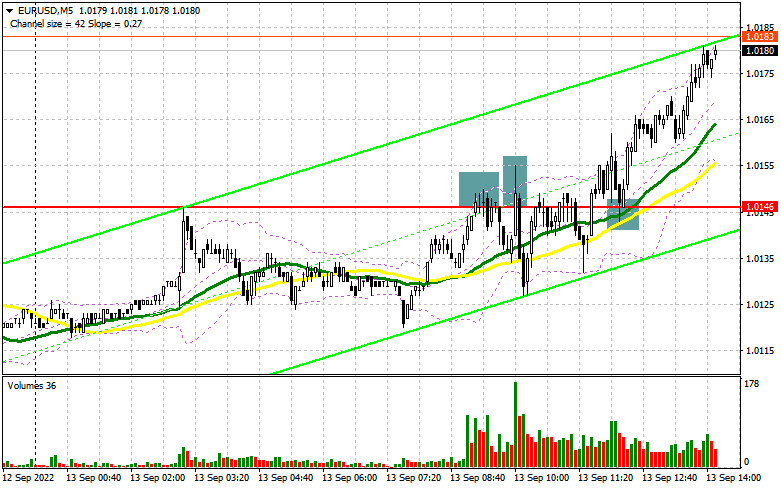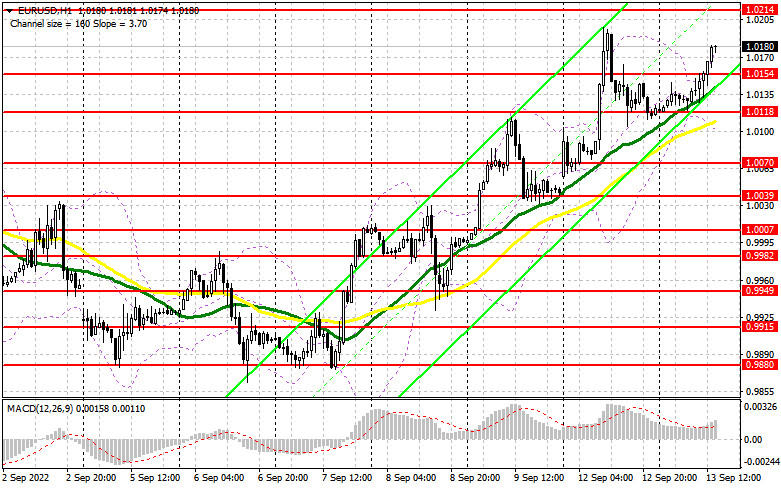
Earlier, I asked you to pay attention to the level of 1.0146 to decide when to enter the market. Let us focus on the 5-minute chart to clear up the market situation. In the first part of the day, gloomy data from Germany and the eurozone prevented the euro from rising above 1.0146. As a result, traders received a sell signal after a false breakout. However, the sell-off was insignificant as traders switched to the data from the US. The pair dropped just by 20 pips.

Conditions for opening long positions on EUR/USD:
Now, traders are fully focused on the US inflation report. In August, inflation may slacken more than in July, thus supporting the euro. Against the backdrop, traders are ready to buy the euro even from monthly highs. The fact is that slackening inflation may affect the Fed's decision on the key interest rate hike. The slower the Fed raises interest rates amid a rapid benchmark hike in the eurozone, the more the greenback may lose. Meanwhile, the euro will be in great demand, which will push it from the parity level. If the pair drops during the US trade, it will be better to buy after a false breakout near the support level of 1.0154. This will provide traders with an entry point with the target at 1.0214. Notably, the uptrend becomes stronger every day. A breakout and a downward test of this level will affect bears' stop orders. This will give an additional long signal with the target at 1.0243. The next target is located at the resistance level of 1.0267, where it is recommended to lock in profits. If the euro/dollar pair falls in the second part of the day and buyers fail to protect 1.0154, traders should avoid buy orders. In this case, traders may go long after a false breakout of 1.0118, where there are bullish moving averages. It is also possible to buy the asset after a bounce off 1.0070 or even lower – from 1.0039, expecting a rise of 30-35 pips.
Conditions for opening short positions on EUR/USD:
Bears will return to the market if US inflation resumes climbing. There are no other reasons to sell the euro. That is why traders should focus on new monthly highs. If the euro jumps, a false breakout of 1.0214 will give a perfect sell signal. The target will be located at the support level of 1.0154. A breakout and settlement below this level will give an additional signal to sell the euro. In this case, the price may return to 1.0118, where it is recommended to lock in profits. The next target is located at 1.0070. If the euro/dollar pair increases during the US trade and bears fail to protect 1.0214, the uptrend will become stronger. In this light, traders should avoid sell orders until the price hits 1.0243, but only after a false breakout. Traders may go short after a rebound from the high of 1.0267 or even higher – from 1.0307, expecting a decline of 30-35 pips.

COT report
According to the COT report from August 6, the number of short positions dropped, whereas the number of long positions surged. Such changes did not come as a surprise. The fact is that the situation took place before the ECB meeting, during which the regulator raised the benchmark rate by 0.75%. Since the difference between the key interest rates of the ECB and the Fed is narrowing, demand for the euro will gradually rise. However, we should keep in mind that the European economy is going through tough times. The winter is expected to be challenging, especially amid high energy prices. The Federal Reserve is also planning to raise the benchmark rate by 0.75% as early as next week. However, a lot will depend on inflation figures. If the consumer price growth remains fast, the regulator will remain stuck to the current stance. The COT report unveiled that the number of long non-commercial positions increased by 3,019 to 205,277, whereas the number of short non-commercial positions decreased by 8,308 to 241,626. At the end of the week, the total non-commercial net position remained negative but rose slightly to -36,349 from -487,676, which indicates the first prerequisites for an upward correction. The weekly closing price decreased to 0.9917 from 1.0033.
Signals of indicators:
Moving Averages
Trading is performed above 30- and 50-day moving averages, which points to a further rise.
Note: The period and prices of moving averages are considered by the author on the one-hour chart, which differs from the general definition of the classic daily moving averages on the daily chart.
Bollinger Bands
If the pair drops, the support level will be located at the lower limit of the indicator near 1.0105.
Description of indicators
Moving average (moving average, determines the current trend by smoothing volatility and noise). The period is 50. It is marked in yellow on the chart. Moving average (moving average, determines the current trend by smoothing volatility and noise). The period is 30. It is marked in green on the graph. MACD indicator (Moving Average Convergence/Divergence - convergence/divergence of moving averages). A fast EMA period is 12. A slow EMA period is 26. The SMA period is 9. Bollinger Bands. The period is 20. Non-profit speculative traders are individual traders, hedge funds, and large institutions that use the futures market for speculative purposes and meet certain requirements. Long non-commercial positions are the total number of long positions opened by non-commercial traders. Short non-commercial positions are the total number of short positions opened by non-commercial traders. The total non-commercial net position is a difference in the number of short and long positions opened by non-commercial traders.